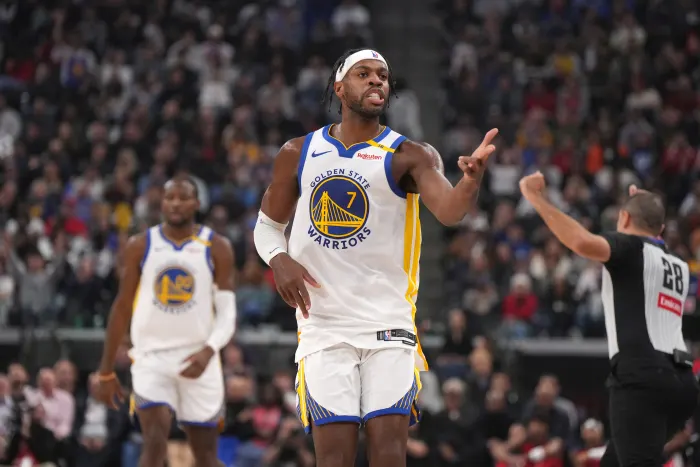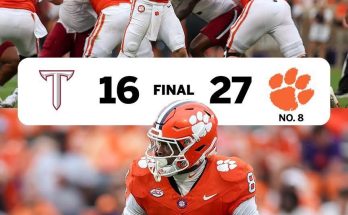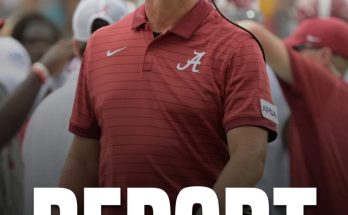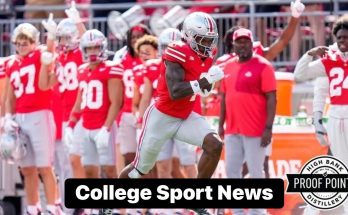Amid the ever-swirling whirlwind of NBA rumors, trades, and internal tension, one offseason storyline gaining unexpected momentum is the evolving dynamic between Buddy Hield and Jonathan Kuminga within the Golden State Warriors. Hield, a recent addition to the Bay Area roster, has quickly made it clear where he stands regarding the Kuminga saga—an offseason filled with speculation, scrutiny, and significant expectations for the young forward. As the Warriors begin reshaping their identity in a post-Dynasty phase, this subtle internal narrative could prove far more impactful than it first appears.
Jonathan Kuminga entered the NBA with a reputation as a raw but immensely talented athlete. Drafted seventh overall by the Warriors in 2021, he was seen as one of the crown jewels of the team’s attempt to blend a veteran core with youthful explosiveness. Fast, explosive, and defensively versatile, Kuminga embodied the kind of high-ceiling prospect that teams rarely get to develop while contending for championships. Yet, despite flashes of brilliance, his journey has not been linear. Over the past few seasons, Kuminga has grappled with inconsistent playing time, often caught in the philosophical tug-of-war between win-now basketball and long-term development.
This offseason, however, something changed. After another year of fluctuating minutes and an early playoff exit for Golden State, Kuminga’s camp reportedly became vocal about his future role. Whispers circulated suggesting the young forward might be growing frustrated with his lack of consistent opportunity. There were rumblings that he wanted to be treated not just as a project but as a core piece. The Warriors, in turn, found themselves at a crossroads. Do they recommit to developing Kuminga as a centerpiece of their future or explore trade scenarios while his value remains high?
Enter Buddy Hield, a marksman whose journey to Golden State symbolizes a new chapter for both the player and the franchise. Hield’s arrival was met with a mixture of curiosity and optimism. Known primarily for his elite three-point shooting, he offers the spacing and perimeter threat the Warriors lacked at times last season. But what has surprised many is not his offensive prowess—it’s his vocal support of Kuminga during an offseason filled with quiet tension. While not taking sides against the coaching staff or front office, Hield has expressed a clear belief in Kuminga’s value and the need for the team to elevate him, not alienate him.
Hield’s stance is noteworthy because he’s new to the organization. He has no long-standing ties to Kuminga or the Warriors’ culture of continuity. His voice, therefore, carries a kind of impartial weight—one rooted not in loyalty, but in observation. For Hield to speak on Kuminga’s behalf so early suggests he sees something in the young forward that the rest of the league has begun to notice: Kuminga’s ceiling isn’t just theoretical anymore; it’s starting to manifest. His athleticism is still eye-popping, but it’s now paired with improved footwork, better decision-making, and more efficient shooting. For Hield, recognizing this talent and endorsing it publicly is both a vote of confidence and a subtle challenge to the Warriors’ hierarchy.
This offseason has placed a spotlight on the internal voices within the Warriors’ locker room, and Hield’s perspective could serve as a pivot point. In an era where locker room politics often influence rotations and organizational direction, the public and private backing of a respected veteran can do wonders for a young player’s psyche and perception. Hield has been around the league long enough to understand how momentum, perception, and internal alignment can affect a player’s trajectory. By stepping in and advocating for Kuminga, he’s effectively putting his stamp on a conversation many within the Warriors’ orbit have tiptoed around.
Kuminga, for his part, has remained mostly quiet. He hasn’t openly demanded a trade, nor has he expressed displeasure in bombastic terms. Instead, his message has been channeled through offseason workouts and summer training footage that paint the picture of a young man locked in. His body looks stronger, his handles tighter, and his patience more refined. It’s not the cry of a disgruntled player—it’s the statement of someone preparing to make his demands on the court. For the Warriors, the pressure now lies in how they respond.
The presence of Hield only adds to the complexity of this decision-making process. On one hand, his shooting will stretch defenses, potentially opening more space for Kuminga to drive and cut. On the other hand, roster depth and rotation decisions will still come down to Steve Kerr and his coaching staff. Kerr has often leaned on veterans, favoring institutional knowledge over youth, but recent seasons have shown that even the core of Stephen Curry, Draymond Green, and Klay Thompson needs help. If the Warriors are to extend their competitive window, they can’t afford to bury talent like Kuminga on the bench.
Hield’s endorsement subtly nudges the Warriors toward a new reality. The team can no longer ride the championship wave of past glory. They must recalibrate. And in doing so, they need to allow players like Kuminga to emerge not just as side pieces but as foundational elements. Hield’s clarity, therefore, is less about politics and more about urgency. He knows the NBA is a business of windows, and the Warriors’ window—at least in its current form—is narrowing.
For all his accolades as a shooter, Hield has also been a student of locker room dynamics. He’s seen how dysfunction or poor communication can sink promising teams. He’s witnessed how nurturing the right players at the right time can elevate a franchise from decent to dominant. His stance on Kuminga is a reflection of that wisdom. He’s not just campaigning for a teammate; he’s encouraging the franchise to seize a moment before it slips away.
The Kuminga saga, then, is more than a developmental story—it’s a referendum on the Warriors’ transition. It’s a test of their ability to adapt, evolve, and embrace generational change. Kuminga represents potential, the kind that can reshape games and redefine lineups. But potential needs faith. It needs playing time. It needs structure without constraint. If the Warriors can’t or won’t provide that, they risk losing more than just a player—they risk losing relevance in a league that waits for no one.
Buddy Hield’s voice, amid this, is not noise—it’s signal. A clear, grounded signal from a respected vet who sees what Kuminga can become and knows what happens when talent is stifled. His stance challenges the front office, coaching staff, and even fans to reconsider what the future of Golden State basketball should look like. Not as a eulogy to the dynasty, but as a rebirth fueled by new stars, reimagined roles, and a willingness to bet on youth.
Whether the Warriors heed this message remains to be seen. The NBA is filled with stories of “what could have been.” Kuminga’s career doesn’t need to be one of them. With support from voices like Hield, a clearer path forward is possible—one where the past is honored but the future is finally given room to flourish.



